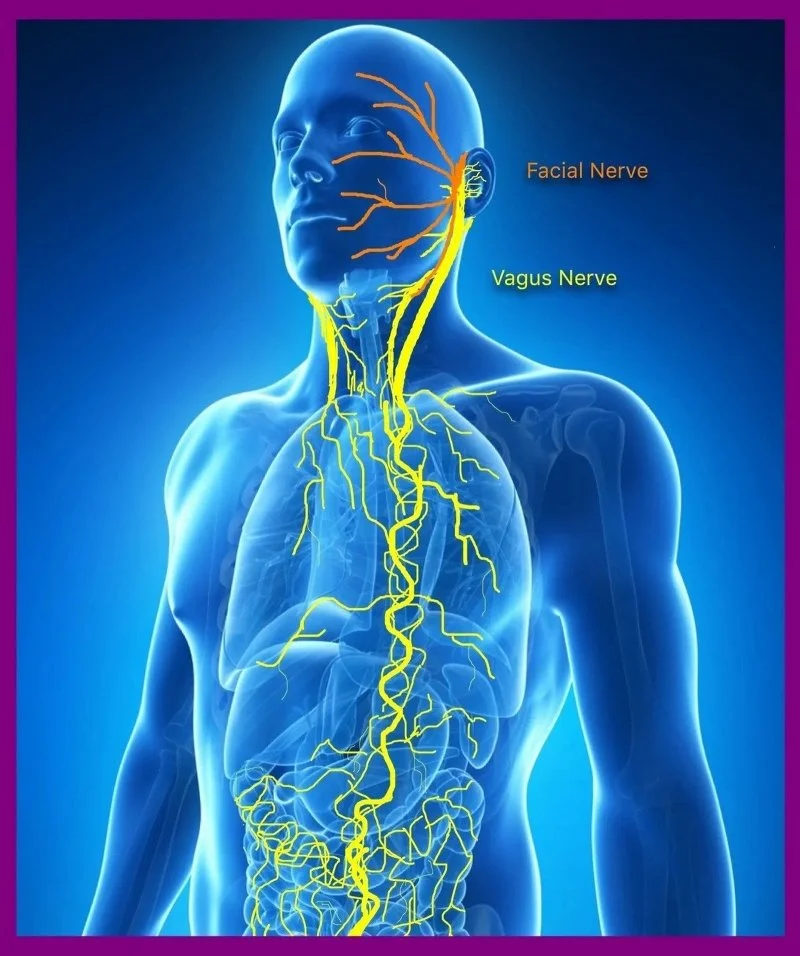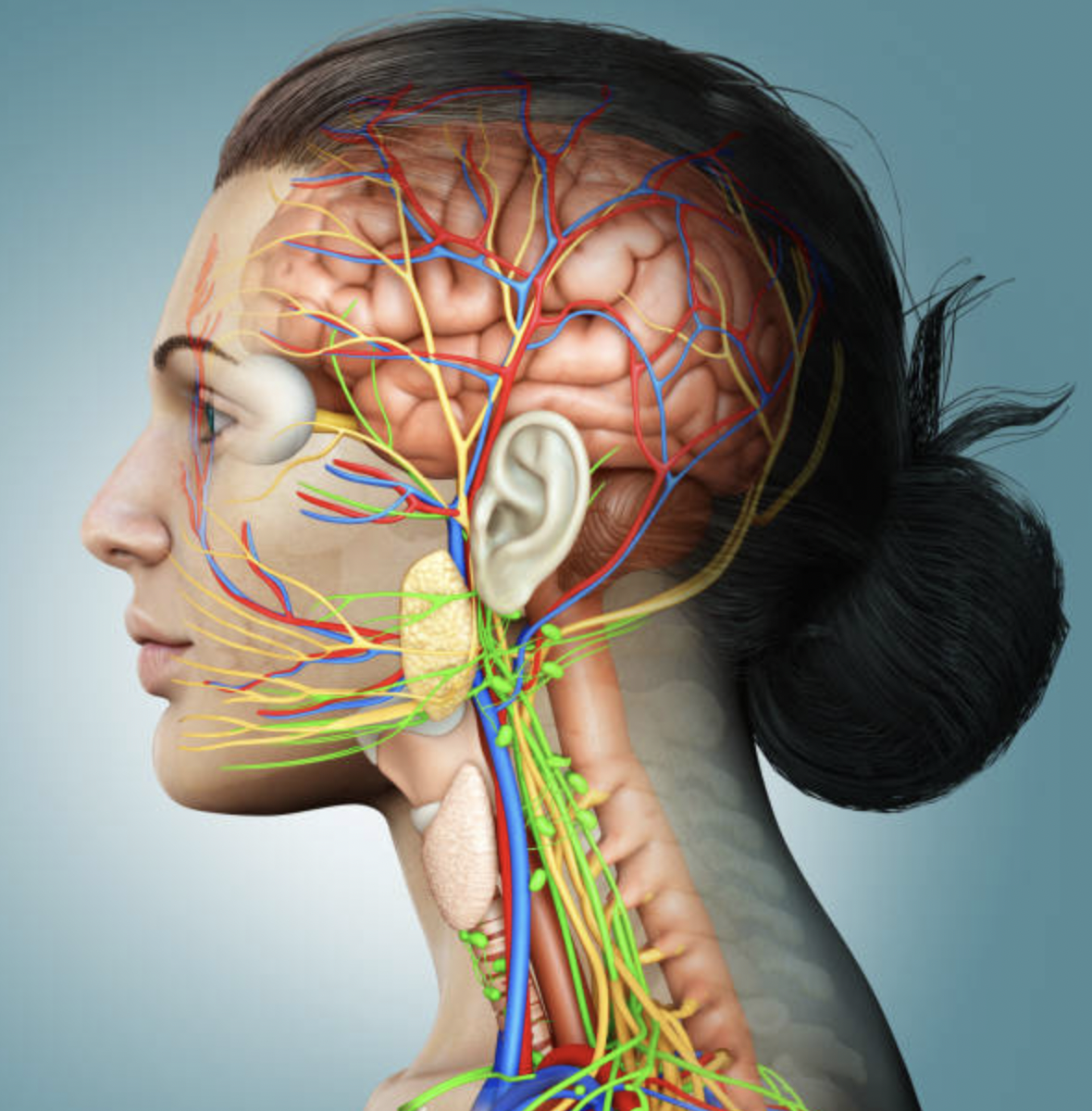Vagus Nerve Function, the Thyroid, and Transcutaneous Nerve Stimulation
Hello, I am Julie Donaldson and I am a clinical nutritionist with functional medicine training. I specialize in restoring balance in complex, chronic and acute health conditions. I welcome you to peruse other articles that may be of interest to you in your health investigation!
“I urge you not to waste another minute starting your healing process with Julie Donaldson! No one got to the root of my problems like she did, and the use of tVNS therapy was a lifesaver no one else even talked about. I am beyond grateful for her experience and wisdom.”
The thyroid is truly a canary in the coal mine. Thyroid disease/imbalance is one of the most common issues we deal with in functional health care today and it has multiple intersections with other glands and organs in the body. In this article, we will talk about low Vagus nerve function, suppression of thyrotropin releasing hormone (TRH) and low thyroid stimulating hormone (TSH). tVNS (transcutaneous vagal nerve stimulation) is a promising non-drug approach for tricky thyroid conditions. We will explore what it is and how it can work to help correct these imbalances with holistic health care approaches.
Thyroid gland location
Let’s talk about the thyroid gland
It is a small butterly-shaped gland in the lower anterior portion of your neck. It is responsible for regulating a number of hormones and mineral balances in your body.
The thyroid makes hormones which are secreted into the bloodstream. One is called thyroxine. This hormone contains four atoms of iodine and is referred to as T4. Another is called triiodothyronine, which contains three atoms of iodine and is called T3. The human body cannot produce iodine on its own, therefore we all must obtain the iodine we need from external sources. Foods that are rich in iodine include eggs, some grains, meat, seafood, kelp, seaweed, and dairy products. Many people also obtain some of the iodine they need for proper thyroid function from iodized salt.
The body’s supply of iodine becomes depleted when the thyroid uses more iodine than the individual is consuming. This may occur among individuals who do not consume iodine-rich foods on a regular basis. Iodine may also become depleted in individuals who have reduced their overall intake of salt, as well as those who have replaced iodized salt with kosher or sea salts.
In the cells and tissues of the body, T4 is converted to T3. T3 is the biologically active hormone in your cells. Conversion of T4 to T3 is supported by enzymes produced in the liver and is under feedback control with your body’s sex hormones as well as with thyroid hormones that are produced in the hypothalamus and pituitary gland. These are thyrotropic releasing hormone (TRH) and thyroid stimulating hormone (TSH), respectively.
The thyroid also makes calcitonin which helps to regulate levels of calcium and phosphorus in the body. Thyroid hormones act as messengers, affecting cells and tissues throughout your body. Their messages affect the body's metabolic rate, or the speed at which energy is being activated in the body. Calcitonin is released by the thyroid gland if the amount of calcium in the bloodstream is high. Calcitonin decreases the amount of calcium and phosphorus in the blood. It does this by slowing the activity of osteoclasts, specialized cells found in the bones. These cells cause calcium to be released as they 'clean' bone. Calcitonin also accelerates the amount of calcium and phosphorus taken up by bone. Calcitonin works together with parathyroid hormone to regulate these mineral levels.
Thyroid imbalances are very prevalent in our population
Over 20 million Americans have some form of thyroid disease. It is also estimated that over 60% of those diagnosed with a thyroid condition are unaware of its presence, hence there are likely many more millions of us with undiagnosed conditions.
What causes thyroid disease? Some of the contributing factors can include:
Diabetes
Lupus
Adrenal insufficiency
Pituitary gland dysfunction
Low estrogen
Excessive or deficient iodine
Age
Liver stress
Mental/emotional stress chemistry
Persistent sympathetic nervous stimulation
Smoking
Medications
Low selenium
High histamine
Low consumption of iodine-rich foods
Another critical topic is the presence of glyphosate in our soils and foods. It has been determined that glyphosate is contributing to the increase in thyroid diseases worldwide. Glyphosate is a highly toxic compound used in conventional farming herbicide formulas. It has also been associated with non-Hodgkins lymphoma. There is a correlation between farmers’ exposure to glyphosate-based herbicides, altered thyroid hormone levels and/or incidence of thyroid pathologies.
Glyphosate alters the absorption of selenium, the functioning of calcium channels and it disrupts oxidative phosphorylation, all of which are involved in thyroid function. Oxidative stress is present in autoimmune thyroiditis and in thyroid cancers. Also, the regulation of the hypothalamus-pituitary axis is very complex, with several steps that can be negatively affected by xenobiotics like glyphosate.
Gluten consumption is also a topic that deserves considerable attention as we discuss thyroid disease.
In Hashimoto’s thyroiditis, antibodies that attack the thyroid are present. It is believed that when someone with Hashimoto’s eats gluten, those antibodies react because the protein structure of gluten is similar to the structure of thyroid tissue. Gluten is a group of storage proteins, mainly glutenin and gliadin, that is found naturally in certain foods such as wheat, barley, and rye. It’s also sometimes used as an additive in processed foods to improve texture and flavor. Removing gluten from the diet for a person with thyroiditis and/or celiac disease is key to recovery.
Last but not least, we must consider the ramifications of fluoridated drinking water. Studies show that excess fluoride has detrimental effects upon the thyroid and thyroid hormone levels. We also know that excess fluoride causes oxidative stress which can contribute to thyroid disease. Healthy water is no longer a given in most US municipalities, and at True Nature, I always recommend home water filtration.
Following are many of the signs/symptoms of a thyroid condition:
Fatigue
Insomnia
Cold or hot extremities
Inability to gain or lose weight
Dry hair
Forgetfulness/poor concentration
Hoarse voice
Racing heart, inability to calm
GI tract dysfunction, including bloating, pain and motility changes
In this multitude of potential responses to an imbalanced thyroid, it is very important to carefully investigate health history and comprehensive blood chemistry analysis to determine if symptoms are, in fact, associated with a thyroid condition. Numerous other pathogenic, toxic and metabolic issues may be causative with the same symptoms.
Now let’s talk about TRH
Thyrotropin-releasing hormone (TRH) is a hormone produced by neurons in the hypothalamus that signals the release of thyroid-stimulating hormone and prolactin from the anterior pituitary. TRH is stimulated when the hypothalamus in the brain perceives low levels of T3 and/or T4 in the body. TRH levels have been found to correlate with normal Vagus nerve function. In particular, when a person is supplementing with thyroid medication, TRH may become suppressed and the red flag may show up in blood testing with very low TSH. A good functional range for TSH is 1.7-3.4. Many people who are supplemented with thyroid medication can test at levels under .07. So, what is the meaning behind this? Let’s include the Vagus nerve in our conversation at this point…
Vagus nerve function and its communication with TRH
The largest nerve in the human body is the Vagus nerve. It begins in the brain and reaches throughout the trunk of the body. Its action is bidirectional, both delivering information to the organs of the body and receiving sensory information there to be returned to the brain.
Vagus nerve anatomy
A truly important study has shown that TRH has significant impact upon Vagus nerve tone and function. When TRH is reduced (again, potentially by thyroid medications), Vagus nerve function is suppressed. In another article, I have shared numerous possible negative impacts upon Vagus nerve function.
As Vagus nerve function becomes suppressed, we will also begin to see complications with gut function. In this scientific article, the issues with gastric acid (HCL), enzymes and bowel motility are highlighted. As vagal flow is diminished, so are the “juices” necessary for proper digestion and motility/emptying of waste. This, of course, creates a ripe environment for conditions like constipation and SIBO (small intestinal bacterial overgrowth). So, where many believe that their gut problems are associated with “slow metabolism” created by a diseased thyroid, here I am sharing the little-known connection with the Vagus nerve and how its function is related to the thyroid and gut health.
The Vagus nerve is a key component of the neuro-immune and brain-gut axes through a bidirectional communication between the brain and the gastrointestinal (GI) tract. It has 4/5 afferent (relaying sensory information from tissues to the brain) nerve fibers and 1/5 efferent (relaying information from the brain to the organs/tisues) nerve fibers. A dual anti-inflammatory role of the Vagus nerve is observed using either vagal afferents, targeting the hypothalamic-pituitary-adrenal axis, or vagal efferents, targeting the cholinergic anti-inflammatory pathway. Remember, both the hypothalamus and the pituitary gland are involved in thyroid stimulation/regulation.
The sympathetic nervous system and the Vagus nerve act synergistically via the splenic nerve to inhibit the release of tumor necrosis factor-alpha (TNF-α) by macrophages of the peripheral tissues and the spleen. (This synergistic partnership requires choline to activate the cholinergic pathway. Choline is a crucial cofactor in the body, often deficient and therefore another possible contributing factor to poor vagal function.) Elevations of TNF-α that may be associated with these compromises can create a cytokine storm that is damaging to the health of the GI tract. TNF-α is an inflammatory cytokine that is responsible for a diverse range of cell signaling, necrosis and cell death. While important for resistance to infections and cancers, like many chemicals in the body, it becomes unhelpful in excess.
I will not be leaving you just with the problem, however - let’s now talk about a unique solution!
Impacting a dysfunctional thyroid with tVNS (transcutaneous vagal nerve stimulation)
Below is a wonderful image of the Vagus nerve and its location next to the ear. With tVNS therapy, we are able to make contact with the nerve with the use of ear clip electrodes connected to a TENS (transcutaneous electrical nerve stimulation) unit. Many people are familiar with the use of TENS for muscle and circulatory issues throughout the body, but it is now being researched extensively for other uses, including Vagus nerve stimulation for the healing of many challenging conditions, including this one which is the focus of our conversation.
Vagus nerve innervation by the left ear
With daily tVNS therapy sessions of approximately 10-15 minutes, thyroid imbalances as well as thyroid-related gut imbalances may be successfully attenuated. Placing ear clips on the tragus of the left ear which are connected to a TENS unit, the Vagus nerve is directly stimulated with a variety of frequencies and duration. This allows tonification of the nerve that may be failing via the afferent and efferent pathways. (Neurons in the Vagus nerve receive efferent input from TRH-containing fibers which arise in the brain.)
Again, when TRH is suppressed due to supplemental thyroid hormones and its ability to impact Vagal tone and gastric function are inhibited, tVNS provides a safe, effective, therapeutic solution.
The estimated rate of occurrence of SIBO with hypothyroid conditions is about 54%. We know that SIBO involves slowed GI tract motility in most people affected. Here, promising research shows the effectiveness of tVNS therapy for the treatment of gastric motility. This is another way in which we see that the thyroid is the canary in the coal mine, as SIBO is often connected with toxicities and estrogen issues - and estrogen is a key player in thyroid health. As always at True Nature, we are seeking to understand the intersections between a variety of dysfunctional expressions in the body. This increases our effectiveness in healing complex, chronic conditions. For more information, visit us at www.truenaturehealthconsulting.com. Let’s talk about smart alternatives for your thyroid problems. We provide holistic telehealth services.




